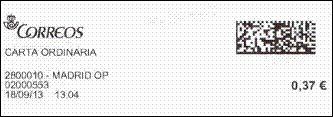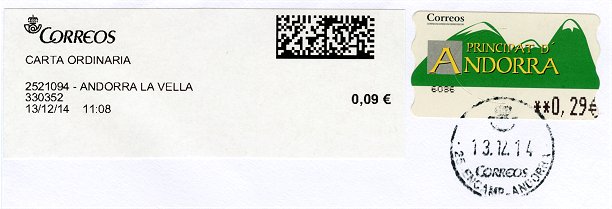| SPAIN. CORREOS - The 'single label' system |
| In mid-October 2005, Spanish Post - Correos launched a trial at three post offices of a new mail franking and admission system not using variable value stamps (ATMs), and known by the acronym AOSE (Admisión en Oficina Sin Estampilla - Admission in post office without stamp). |
 |
After using different types of ATMs and variable value stamps as a postage option, for more than 25 years, Correos finally decided on their elimination - It was the beginning of the end for ATMs in Spain.
This pilot was extended, during December 2005, to thirty other post offices throughout the country, which began to use different hand and mechanical Franqueo pagado en oficina (Postage Paid at post office) postal marks.
| The end phase of this process of elimination of ATMs began in November 2006. Since then all post offices connected to the Correos network software, the IRIS application, stopped the issue of variable value stamps and, instead, began to frank the postal items using a wide variety of Postage Paid at post office postal marks. |
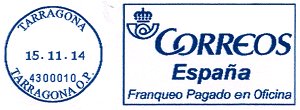 |
Only small post offices fitted with stand-alone franking scales, not connected to the IRIS network, continued to issue variable value stamps (ATMs) for franking. Also some self-service LF vending machines continued in service, in some post offices, issuing such stamps.
This new mail admission system caused distrust in some customers, and created an obvious problem of lack of control on admission. With just a 'Franqueo Pagado' postal mark, hand applied in most cases (right image), there was no method of controlling or verifying that the postage tariff had been paid, on any postal item brought to a post office. Put another way, employees could accept postal items into the postal system, without charging the postage.
We published various articles related to this process on this website and in different issues of VARIABLE. |
 |
Surprisingly, the first clear response to this serious problem did not arrive until three years later. In September 2009, Correos launched a tender for the purchase of 69 new franking scales that could issue a new model of single variable value stamp, including a 2D or Datamatrix code.
The tender was awarded, in December 2009, to the Spanish company Grupo Epelsa S.L., who developed a new model of franking balance called the Epelsa DLT-ARM.
The trial with ten scales began on March 3rd 2010, in the Badajoz main post office (right picture) and the Don Benito post office. |
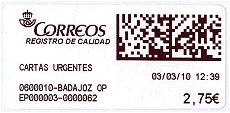 |
(See article 'Regain control. The pilot test with the new ARM variable value stamps', also published in VARIABLE 16).
However, this first project, limited in many aspects, was discontinued.
| The 'Single label' system |
In mid-December 2012, the president of Grupo Correos launched the Plan de Acción 100-300-1500, a plan establishing different actions to transform the company. One of the strategic lines of this plan was the operational optimisation that would maximize the company infrastructure. Along this line, in 2013, Correos focused its efforts on finding solutions that would improve and simplify the admissions processes at post offices. Among other measures, one of the options considered was the introduction of the 'single label' for all postal items. It is a new franking label with a barcode for all products and services, which allows total control and maximum flexibility of the admission process.
| After initial tests in Madrid, in September 2013 (upper images), Correos began, in late 2013, a pilot at six post offices - the main post offices of Albacete and Badajoz, Madrid postal branches 44 and 47 (images), and the post offices of Don Benito (Badajoz) and Algete (Madrid). Some of these post offices had also been involved in the tests with the Epelsa DLT-ARM franking scales, in 2010. |
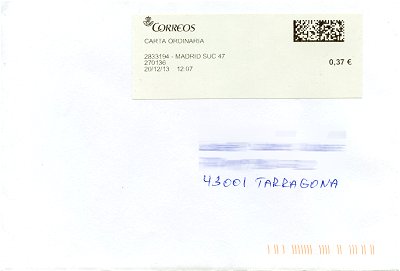 |
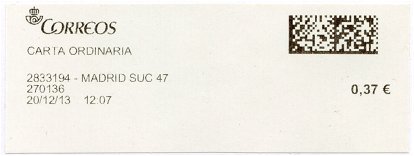 |
After verifying the results of this pilot, Correos decided on the final implementation of the 'single label' at all its post offices in Spain and Andorra. In early March 2014, Correos launched a tender for the 'acquisition, configuration, installation, maintenance and support of 5,800 thermal printers, and the acquisition of a maximum 62,000 rolls of self-adhesive labels'.
The tender was awarded, in July 2014, to the ATOS SPAIN S.A.U. company, worth 3,663,740.85 EUR. The printer chosen to print the new franking labels was the Zebra GX420d, a direct thermal printer with a resolution of 203 dpi.
The project involved the installation of the new printers at all the mail admission counters in the 2,373 post offices connected to the IRIS network. The installation of the major part of the equipment began in September and continued during the last quarter of 2014.
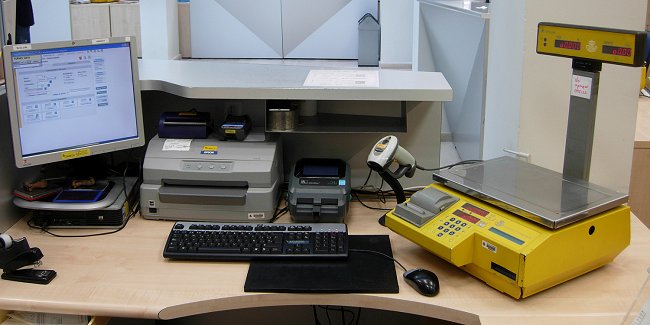 |
| Equipment installed at a Correos post office counter (December 2014); from left to right, the monitor with the postal software application for mail admission, an Epson dot matrix printer for registration slips, invoices and other documents. The new Zebra GX420d for franking labels, a barcode scanner, and the Epelsa franking scale, now only used for weighing and issuing the receipts imprint on thermal paper. |
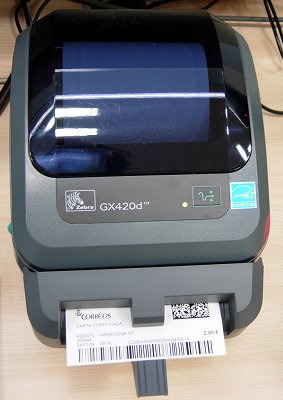 |
At the operational level, the project goes beyond the earlier 'Epelsa' variable value stamps type and similar. After installation of new printers and modifying the mail admission application used at all Correos post offices, the system issues a new 'label' or stamp with all information about the shipment and its characteristics. This system therefore allows full control over the stamps issued and revenue.
Regarding the stamps of franking labels issued. Unlike previous franking scales, the new printers use rolls of thermal paper without backing paper, linerless label rolls with a width of 100 mm. The use of this type of roll without backing paper increases the length of paper available on the roll, and significantly reduces waste and streamlines the employees work.
To avoid confusion and errors, the printer has a sensor that prevents printing and cutting of a new stamp until the employee has withdrawn the previous one from the output tray. |
New postage stamps for immediate use are similar to those issued by many other postal administrations, including Germany, Switzerland, Italy (TP Labels - see article >, also published in VARIABLE 13 and 24), ... The stamps have a variable size, depending on the type or characteristics of the shipment. For letters in the first weight steps, the resulting stamp has a size of 100 x 37 mm. For heavier letters and packages, with additional services, the size of the postage label is 147 x 100 mm.
 |
For regular mail, the new stamp includes a block on the left with the Correos logo, the type of service (CARTA ORDINARIA - ordinary letter, pictured), the Codired or post office code and name (4300010 - TARRAGONA OP), the employee NIP (*) (363844), and the issue date and time. |
On the right, a two-dimensional code or Datamatrix with all the information about the shipment and franking, and the face value.
(*) The Número de Identificación Profesional - Professional Identification Number (NIP), in force since July 2009, is a unique and personal eight-figures number for each Correos postal employee. This number is generated when the employee joins the company and remains unchanged during his/her entire career in the company.
 |
In the case of registered mail, the franking labels also includes a symbol of the shipment type in the center of the label (C -Certificado- in the picture, CU in the case of urgent registered shipments, etc.), and the shipping code and the bar code on the bottom part of the label. |
If the postal item includes a partial prefranking (image below, Andorra) or is fully prefranked, the system issues a complementary stamp, or just a franking label with no face value and the shipment barcode, in the case of registered mail (image below).
The new 'single label' system was also implemented, in late November 2014, in the Andorra post offices connected to the IRIS system. Offices at Escaldes-Engordany, Encamp, ... are just 'satellite offices' of the Andorra la Vella main post office, so the post office code -Codired- and the post office name, printed on the franking labels issued by the five printers installed in Andorra, is identical on all of them (2521094 - ANDORRA LA VELLA). Only the employees NIP and, if applicable, any additional postal mark, allow us to know the origin of the stamp.
These new franking labels or stamps are intended for immediate postal use when handed in at the Correos admission counters. Because of the nature of the system and the specific conditions of issue, it is not possible to buy these stamps for future usage or storage. Furthermore, in terms of collecting, it is important to emphasize that the thermal printing on these stamps fades very rapidly, making medium term conservation difficult.
ATM Web - Spain and Latin American Postal Services: http://www.ateeme.net
© J. Jove - ATEEME. Variable value stamps study group. All rights reserved
This page was created in December 2014, and last updated:
28.12.14
. English edition rewritten by S. Goodman (28.12.2014)
|




